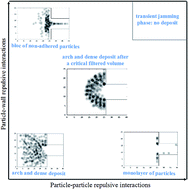Collective dynamics of flowing colloids during pore clogging†
Abstract
Based on direct numerical simulations of the coupled motion of particles and fluid, this study analyzes the collective hydrodynamic and colloidal effects of flowing microparticles during the formation of different 3D clogging patterns at a pore entrance. Simulations of flowing suspensions through a pore with various simulation conditions show that particle concentration and surface interactions play a major role in the occurrence of the bridging phenomenon (simultaneous adhesion of many particles). In the absence of DLVO repulsive forces, plugging is characterized by the temporal reduction of the bulk permeability when increasing the volume fraction of the flowing suspension up to 20%. Under these conditions, different structures of particle aggregates (from cluster to cake plug) are formed at the pore entrance yielding different evolution rates of hydrodynamic resistance to the flow. Taking into account DLVO repulsive forces in simulations for a particle concentration equal to 10%, we observe the transition from dendritic structures (for low repulsion) to dense aggregates (for high repulsion). At high DLVO repulsive forces, the scenario of pore clogging is controlled by the collective behavior of many interacting particles. It leads to the formation of a jamming phase (Wigner glass phase) with transient clusters of interacting particles at the pore entrance. The network of jammed particles collapses when the force chains among the particles are overcome by the flow stress. The build-up and the collapse of the jammed phase at the pore entrance induce temporal permeability fluctuations. According to the relative magnitude of particle–particle and particle–wall interactions, when the jammed phase is disorganized by the flow, the residual force in the network can accelerate particles and lead to particle adhesion at the wall inducing a pore blockage and a rapid reduction of the bulk permeability.


 Please wait while we load your content...
Please wait while we load your content...